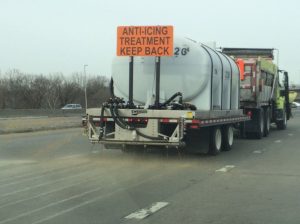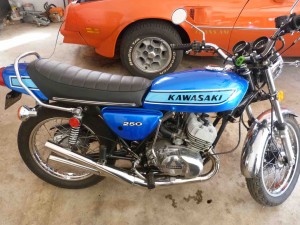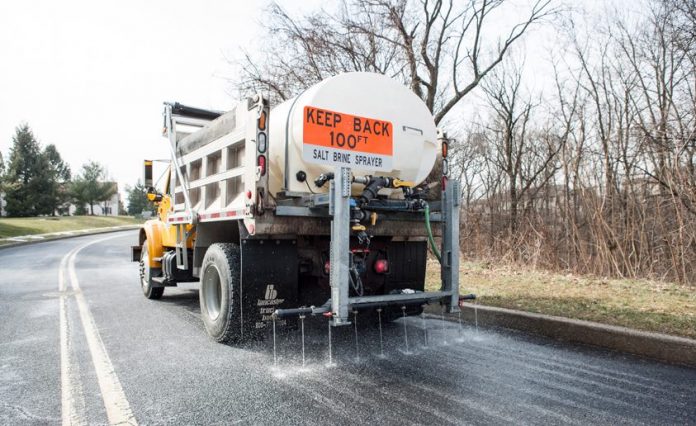It’s a problem that there are so many old cars – and trucks – still on the road. Well, it’s a problem for those who want very much to get you out of your old car or truck – and into a new one.
Ideally, electric.
Cars – and trucks – are lasting too long. The average age of a currently-in-service vehicle is about 12 years old. Interestingly, most of those date back to the time before cars and trucks came with layers of “assistance” technology and weren’t “connected.” The people who have them often very much want to keep them rather than buy anything new, let anything electric.
Enter the brine.
As distinct from the salt they used to spread on the roads . . . when it actually snowed. In many areas of the country, the salt has been replaced by liquid brine – which is sprayed on the roads before it snows.
Often, even when it doesn’t snow – but looks like it might.
Just in case! Saaaaaaafety first!
Like so many other things most people didn’t used to be terrified of, even the possibility of snow – even if it’s just flakes – incites a TeeVee-driven mass panic of milk-and-bread getting. A snowflake – singular – that wafts onto a windshield provokes a response as similarly disproportionate in some people as the wearing of multiple Face Diapers and “distancing” rigmarole to ward off a “virus” that didn’t kill 99.8-something percent of us. Some of the snow-fearful will turn on their hazard lights and drive at walking pace on roads with 55 MPH speed limits if the sky gets dark. If you pass them, they furiously flash their headlights at you, to the accompaniment of angry horn-honking.
This is ironic, given that almost all the cars on the road nowadays are front-wheel-drive/all-wheel-drive and for that reason are much better in the snow – if it actually does – than the rear-drive cars of the bad old days, when it did actually snow and the roads were only salted after it began to snow.
This brine is hugely effective . . . at rusting out cars and trucks.
If you’ve had yours immersed in this stuff – and that’s just the right word, as driving through freshly sprayed brine is like driving through water dumped on the road by a passing storm that hasn’t had time to wick off the road – you probably know all about it already. If you’ve had to work on your car, after the brine has had a chance to its work, you know something else.
The stuff leaches into everything – being a liquid. Rock salt stayed mostly on the road. It only turned to liquid along with the snow, as it melted. Then it also did its corrosive thing, but in a more diluted way – being watered down (literally) by the melting snow.
But brine is 100 proof – and there is often no snow on the road to dilute it.
You’re forced to drive right through it.
Which leads to what I recently had to deal with, underside of my 20-year-old truck. It was time to check (and ultimately, replace) its front wheel bearings, which is ordinarily an easy and pretty quickly done job. The main part of it being to remove the hub so as to be able to get at the bearings, races and seals. Before you can do that it is necessary (on my truck) to remove the brake caliper, which is held to the hub a couple of bolts that go through it and through holes in the hub. It also necessary to remove these bolts – in order to remove the calipers – when replacing brake pads, so it’s part of basic maintenance.
The bolts usually come loose easily – if they haven’t been rusted, internally. Mine were – badly – and it took all of Captain Freedom’s mighty biceps (plus a long breaker bar, for leverage) to break them loose. One almost broke – which would have meant having to drill/tap the caliper or just chuck it and buy a new one.
Luckily, all it did was bend a little on the way out, one bicep-straining quarter-turn at a time. But the wavy-gravy bolt is now useless, so off to the parts palace to try to get new ones. All four (two per caliper) because even though the others aren’t bent – yet – they are rusted, now.
Courtesy of the brine.
Which also rusts everything else exposed to it with remarkable efficiency. Steel fuel and brake lines. Suspension parts; the bolts that hold those parts to the frame – and (worst of all) the frame, itself. Once that’s no longer structurally sound, the soundness of everything else no longer matters. Your older vehicle’s engine might be as tight as the day it left the factory; the transmission in perfect working order. Everything in perfect working order. Even the body (and paint) might still look new, or nearly so.
But if the frame rusts out, you’re out of luck.
It can be fixed. But it isn’t easy – or cheap. It requires expert welding (so as to avoid compromising the structural integrity of the thing) or a good used frame. Once found you’ll have to transfer your truck’s body – along with everything else – onto the good used frame.
Assuming you can find one.
Thanks to Brandon, people are clinging to their older vehicles – trucks especially – and those who own examples with good frames aren’t going to donate them to save your rotted out one.
So what can you do to prevent the brine from accelerating the demise of your older car – or truck?
The best thing, of course, is to avoid driving in the brine. But that’s often not practicable, if you need to drive your vehicle when they soak the roads with brine. Next best thing is to wash it off as soon as feasible. Even better is to have coated the underside with heavy oil or similar before you expose your ride to the brine – in order to prevent the brine from eating your vehicle’s undersides.
Or at least, hold it up a bit.
I learned the latter trick by accident – via owning two-stroke motorcycles. They marinate in oil, which covers everything – inside and out. And – what do you know! – they never rust.
Apply the same to your car or truck and it might not, either.
. . .
Got a question about cars, bikes or anything else? Click on the “ask Eric” link and send ’em in! Or email me directly at [email protected] if the @!** “ask Eric” button doesn’t work!
If you like what you’ve found here please consider supporting EPautos.
We depend on you to keep the wheels turning!
Our donate button is here.
If you prefer not to use PayPal, our mailing address is:
EPautos
721 Hummingbird Lane SE
Copper Hill, VA 24079
PS: Get an EPautos magnet or sticker or coaster in return for a $20 or more one-time donation or a $10 or more monthly recurring donation. (Please be sure to tell us you want a magnet or sticker or coaster – and also, provide an address, so we know where to mail the thing!)
My eBook about car buying (new and used) is also available for your favorite price – free! Click here. If that fails, email me at [email protected] and I will send you a copy directly!












I’ve always wondered how you drive such an ancient vehicle. I assumed it was because you live in a different state than me (Michigan).
Here, everything starts rusting by about ten years, and fifteen years old or more usually means that you have holes in the body panels and running boards are a distant memory.
This article reminds me of driving to work on the back roads in the winter, on purpose in my new car. Because they never salted them “just because” and sometimes never got around to it at all. And if you drove a reasonable speed in a FWD car, it felt safer on back roads (even covered by ice) by myself than with idiots riding my ass on the main roads.
Hi Nate,
A couple of things. One, I work for myself, so I can generally avoid having to drive and so don’t, if there is brine on the roads. Two, I am OCD fastidious about my vehicles and keep them clean – including underside clean. Three, I keep my truck garaged. So it stays dry – and dries off faster, if it got wet. Parking outside accelerates corrosion, even absent brine!
We are all used to the typical windshield-full of rock chips and lines from the rocks, due to the sanding of the roads during our long Winters. Our windshields up here would never fly in other state. Well, the DOT decided to added this brine crap a few years ago, and yep, now we all have rust issues, where we did not before. The service advisor at the one dealership had talked to a DOT guy about it once, and the DOT guy said that there was “just a little bit of brine” in with the sand, otherwise it was safe. I told the service advisor, that next time he saw Mr. DOT man, to give him a glass of water, tell him there was “….just a little bit of poison in it”, but otherwise, was safe to drink.
Hi Shadow,
It may be merely the usual hyper-cautionary excess (it might snow! Salt – brine – the earth!) but it nonetheless serves the purpose of early-retiring vehicles bathed in it that would otherwise go 20-plus years before reaching natural retirement age.
Eric, I think you forgot – apart from the saaaffttyyy aspect, given our politicians dont actually care for us, I suspect its pre sprayed so that more is consumed (mostly wasted), the tanker goes out more, which means bigger contracts from the government to a subcontractor, which means more kickbacks for the political / bureaucrat who approved it….
Hi Nasir,
Yup! In my area, they dump brine as soon as the clouds darken. Sometimes even before they do. This empties the trucks – at our expense – and then they are refilled, also at our expense. Over and over and over….
Every time I have to drive in that stuff, I go to the car wash and spray off the bottom of the truck with soap and rinse.
Seems to do a good job at keeping the rust at bay.
The brine doesn’t work. It doesn’t keep snow from laying. Not sure what the point of it is.
Wouldn’t be an issue if people would learn how to drive in the snow or stay home.
The purpose of the brine is to eat your vehicle away much sooner because the vehicle fleet is getting too old. Vehicle taxes are a large theft source of revenue for the stealers of your wealth.
Look into Krown rustproofing
https://www.krown.com/en/
Since the brine rusts a car away I’m wondering what it will do to EV components? A corroded battery might be more likely to spontaneously combust methinks.
Landru – I was also wondering this – it will be fun when you have a bunch of electric cars on the road which are more than a couple years old…. what brine will do to the batteries, connectors, motors, etc….think electric car fires are a problem today!?
Thank God I live in sunny, NW Florida. They put sand on the roads in case of the once every two decades ice event, but it’s so rare here that we don’t often have to worry about it.
The interior of NW Florida close to the Alabama and Georgia state lines still has relatively inexpensive land, very clean and abundant water from the Karst topography (our property has several big springs, including one that feeds our large pond and another that provides all the water we need filtered through the limestone), close to the greatest beaches in the world and great weather, except for the hurricanes. Hurricane Michael did a real number on our property and house, but we were able to get the damage fixed pretty quickly.
Eric, come on down here. It’s also a very Southern area where people have lots of guns and are absurdly polite to one another (think there is a correlation).
Pipe down dr mantis!
The forgotten/emerald coast has been non stop busy all year. Even the winter “off” season was crowded. It’s great for business but the amount of NJ, NY and CA plates I’m seeing is disturbing. Eric would be a welcome addition to our ranks however.
Eric, look up the florida homestead act and property tax exemptions.
For my first motorcycle, in the off season, I would spray *the entire bike* with WD40 prior to mothballing. I guess it worked okay. Another story: One February after the snow, it was warm. Since I never winterize my bike, I take it out in the winter on the few nice days during the winter. That day, there was melted snow/salt on the roads, and I *did not* wash my bike afterwards. Big mistake. All the aluminum was corroded (wheels) They were a pain to restore, which is what I ended up having to do.
Produced water from oil wells will have salt in it, there is a lot of produced water with oil drilling and mining, really, it is mining. There was a Morton salt mine in an oil town in my state, oil and salt are in the same spot sometimes. Brine can have so much salt in it, it won’t freeze at 30 below zero.
Brine from oil wells is used on asphalt to prevent water from freezing to the surface.
One oil search and discovery method is the use of a scintillometer to discover areas where there is no radon gas detected. Oil deposits prevent radon from rising through the lithosphere, a dip in the instrument will indicate a possible oil pool, accumulated unit. The Bakken Depocenter, the place where most of the oil is, is probably 10,400 feet down to get to it, and the oil deposit is a good 75 feet deep and several miles wide. There is between 500 to 900 billion barrels of oil. Leigh Price was the petrochemist who determined the amount in the formation.
Slawson exploration has worked for many years in the Bakken above the Middle Bakken, the Upper Bakken, fissures in the Upper Bakken allow oil to migrate into the Lodgepole, the Lower Bakken cracks and oil deposits below the Lower Bakken. “We are not right-minded,” said a Slawson owner/developer.
Heat and pressure cooks organic content into crude oil, crude oil not as old will have lots of natural gas. If it blows out, there will be 400 feet of drill pipe swinging around in the air. Rig operators earn some bucks out there. EOG is the big dog and Continental is along for the ride.
Old oil deposits have little natural gas, escapes over time. Eventually, the salt dome will collapse. A kame is a potential oil deposit.
Artesian wells can have natural gas dissolved in the water. Leads me to believe natural gas can possibly be abiotic. Natural gas is always seeping from the floor of the Gulf of Mexico.
In the early years of oil development, the State of North Dakota’s geologist ordered all drilling cores to be logged and documented, then stored. The information recorded from core samples are some of the most valuable studies in the entire world and are referenced heavily for oil analysis. Leigh Price deduced that most of the oil in the core samples was lost during drilling and the actual amount of oil in the Bakken Formation is far greater than estimated by US Geological studies. Price also claimed that it could all be pumped out of the ground over time. At a million barrels per day production, 365 million barrels a year, 100 years from now, 36,500,000,000 barrels of oil goes to refineries. Bakken oil makes good jet fuel. If oil exploration and extraction continues, that is how much time it will take. The Madison formation is oil crude oil and is about 3000 feet below the surface. Many oil deposits above and below the Bakken. Ergo, 1200 years of oil production from one formation. The Chinese drilled for natural gas in 2000 BCE. They still do. 4000 years of using natural gas, you’ve honed the skill. There were 300 million Chinese 4000 years ago. They’re not going to stop using because some green nut says so.
There are hundreds of Lodgepole formations above the Bakken Formation and all will have oil deposits. All holes drilled have oil, a duster once in a while does happen, but not very often.
Search and Discovery dot com will be a go to place for information regarding oil exploration.
Oil is everywhere on earth for a reason. How would you get all that brine for blacktop roads during winter weather problems for travel?
187 thousand wells in Texas pumping 13 barrels per day average still adds up to a lot of oil in one day. Pipe or haul it to the refinery. You better make reports to the Texas Rail Road Commission or you’ll be hauled off to the hoosegow. Stolen oil from the Mexican cartels is frowned upon there. It’s gotta be on paper first before you can sell.
You’ll pay five dollars per gallon so you can drive. Can’t avoid it unless you quit driving.
‘You’ll pay five dollars per gallon so you can drive.’ — drumphish
And you’ll be happy. /sarc
Here’s the chart of national average unleaded price, courtesy of Jim Bianco:
https://twitter.com/biancoresearch/status/1534525296619175937/photo/1
It reached a record $4.96 a gallon yesterday. It’s rising about a nickel a day.
Prolly hit fi’ dollah today or tomorrow.
FJB.
Passed SIX bucks a “Galleon” (Gallon) here just east of Sac town. Shit. I’ve been gassing up every WEEK, which, with my relatively limited driving, is about a third-tank, on my 2020 (con)Fusion. Took about 5-1/2 gals this AM on the way to the “orfice”, along with 3/$5 of “rocket fuel” (Rockstars), cost me two pictures of the “Racist” Andy Jackson. They may as well put Harriet Tubman or some other Negress of (bank)note on it; if we’re not already getting out the pitch forks and torches and ready to tar and feather “Brandon”, then we won’t care if our money is FURTHER bastardized, right?
Hi Eric
Get under your truck with a wire brush, remove all loose rust, then paint over all rusted areas with POR15. It stops rust.
If I wire-brushed all the loose rust under my car there wouldn’t be any metal left 😆. It’s an ‘01 Corolla and everything else runs smooth as silk; just had the rusted out brake lines replaced, along with the rear control arms, cost over $1,000 but if it can get me a few more years I’ll still be out of the matrix.
I despise brine;
I use anti-sieze on everything.
You’re lucky your not in the NE or rust belt. 10x worse.
And you can’t wash it off with water. I’ve tried.
Maybe the only answer is keep your prized 10-20yr old car/truck in the garage and keep a sacrificial beater for brine season.
Eric, you’re so close to the land that rust forgot! What keeps you in the communistwealth of Virginia? Sell that tax burdened property for windfall profit and buy a “worthless” low tax mobile or cabin in the sticks of the south. I’ll never regret leaving the northeast hampster wheel of taxes and state destroyed vehicles. Property taxes went from $5k a year to $250 and no more shoveling piles of money into the furnace to avoid burst pipes and freezing to death half the year.
Hi Turn,
I kind of did just that – 20 years ago – when I left Northern Virginia and moved to rural SW Virginia (about 35 miles from downtown Roanoke). Property taxes are about a fourth of what I was paying. But things are changing. The “element” has been moving to this area and one can feel the effects. But I love my place and also the area; and it’s not yet reached critical mass. Of course, I realize that when it does it’ll already be too late. They key is to split (and cash out) just before that happens.
The question then becomes: Where to next? I have maybe one relocation left in me. It has to be for the last time, next time.
Find a place where there’s a dearth of three things: Democrats, Negroes, and Jews.
RE: “TeeVee-driven mass panic”
A couple of years before, ‘The Plandemic’ I noticed how the national TeeVee weathermen would describe an approaching storm system or its after effects as impacting X millions of people in a region.
At the time, I thought that was a really weird shift in the way they described storm systems. In hindsight, I see how it was, and is, a scare mongering technique and likely a purposeful pre-conditioning of the audiences.
Anyway, my 90’s truck has been sitting for months, the frame rotted above the rear axel. I debate about even trying to fix it, so much of the rest of it is badly rusted. Maybe sell it for parts & try and get a gas-sipping, Yugo type tiny car?
Decisions decisions.
Like some guy whose politics I can’t stand now once sung, rust never sleeps. My first 2 vehicles, an 80 and a 94 were in the junkyard 6-8 yrs before the 19 years old my ‘03 is now. And, yup, it’s running like a dream but I’m dealing with an intractable rust issue that has created another problem with the windshield. Despite all my efforts to repair rust holes in the roof, water has, at times, gotten into the top trench and side pillars where the windshield is affixed. In April, when 70 degree weather and heavy rain were quickly followed by freezing temps, the frozen water popped a crack in the windshield. A few weeks later, another from a different spot. You know what happens next.
So I have Safelite Glass come out to replace the windshield. After a few weeks of delay trying to source a 19 year old windshield, the guy comes out, starts poking around under the rubber trims and shows me several holes and paper thin rusted out areas then says he can’t/won’t replace the windshield without professional body work to fix the rust issues. Then I learn what used to cost $2k at the body shop will now be $8k, maybe in 6 months.
So now I’m driving looking through what looks like bloodshot eyes with clear gorilla tape on the cracks so as to try prevent the cracks from powdering. I’ve been told I can still pass inspection though, like I did last year with a ratchet strap holding the rear door closed.
RE: “I can still pass inspection though”
Man, makes me think of: Stand on one foot and rub your stomach while chewing gum, then hop.
“clear gorilla tape on the cracks” I hadn’t thought of that trick. I’ll have to keep that in mind if & when it’s my turn.
Mag chloride has been a boon to the windshield washer industry too. The tenacious stuff gets splashed onto every surface of your vehicle and is brown/black. I go through gallons of the stuff every season.
Once upon a time, the roads were only plowed and treated enough to make them passable, often not until the snow had STOPPED. Schools did not close over a forecast. You were expected to know how to drive on snow, or learn to rather quickly. People did. They also often put on snow tires in the winter. This was before “all season” radials were a thing. The big “trick”. Call them “all season” and people tend to believe they are equal to snow tires. Of course they aren’t, but people think the roads should be cleaned up enough for them to drive care free with these tires. People don’t know how to drive on ice or snow, and don’t want to bother with learning, since it interferes with their sail fawn usage. Before I had to give it up for health reasons, I frequently drove my ’06 Miata, a rear wheel drive sports car, on 2-4 inches of snow, passing numerous SUVs, many of those probably AWD, in the ditch.
Hi John
The Porsche 924 2WD with the transaxle in the back is great in the snow with snow tires.
This 1978 Porsche 924 Is Your Unusual Camper/Rally Conversion of the Day
The car was lifted about 1.6 inches in the front and back and fitted with Nokian R3 non-studded snow tires with big mud flaps all around. A custom roof rack holds a full-size spare tire, gas can, Maxtrax, an axe, and four Comet 500 Hella lights that provide 500 watts to illuminate the unbeaten path ahead.
Inside, the Porsche Overland Project remains mostly stock except for a few important conversions for camping and off-the-grid duty. The 32-year-old sports car was fitted with a new battery, a kill switch, Bluetooth, and a CB radio for starters.
Surprisingly, the car can sleep two people in its modified rear hatch by moving the seats forward, lowering the rear bench, setting up a platform over the rear seat and footwells, and adjusting a mattress. (you could live in it, forget the vans, the only sports car you could live in)…..a good bug out car….
https://www.motorbiscuit.com/off-roading-a-porsche-924-this-rally-build-proves-its-possible/
‘Thanks to Brandon, people are clinging to their older vehicles.’ — eric
They don’t call me a bitter clinger for nothing.
Considering the value of materials and labor embedded in a motor vehicle, it’s very un-green to carelessly rust them out and retire them early — a sin against Gaia, if you will.
Except that’s Big Gov’s agenda. Cash for Clunkers was about replacing older IC vehicles with ‘lower emissions’ newer ones.
Now it’s about retiring the IC-engined fleet altogether, to replace it with EeeVees (sort of like TeeVees with wheels, but equally mind-numbing).
Let’s go Brinedon!
Hi Jim
EV’s pollute more
NOTE: The biggest pollutant emitted from new cars because they have so low emissions are from tires wearing out while driving, tire particles.
ATTENTION: Electric cars weigh 30% more than gas powered cars so have higher tire wear, so EV’s pollute more.
EV highway driving consumption
The advertised range that many manufacturers brag about is the average or city driving figure. However, the highway range is much smaller, sometimes up to 50 percent less.
operating Li-ion batteries outside the safety zone (i.e. 20%–80%) state of charge, a loss in conductivity can be observed
You can only use 60% of the advertised range, in cold weather subtract up to 50% more, so what is the real world range?
ATTENTION: Only 5% of electric car lithium fire bomb batteries are recycled, a huge pollution problem. there is a $4500.00 recycling fee, so lots of them will get thrown in the bush….
In their entire life cycle including manufacturing, electric cars in total pollute far more than gas powered cars, people don’t seem to understand that the vast majority of a car’s carbon footprint is made during manufacture and scrapping. Running the car, not so much. EV’s pollute far more,
Most electric cars are designed as performance cars so they use far more energy and resources than they should. (the government regulations don’t allow the manufacture of small light electric cars which would make more sense, china does).
Recharging costs:
The grid can’t handle large numbers of electric cars recharging, if all cars are electric the grid capacity has to be increased 30x. There is already power shortages, blackouts in many countries with electricity costs rapidly rising, when electricity prices go up 400% your old ice vehicle will look cheap to run.
Open pit lithium mining for battery manufacture, often done with child slave labour, is worse then tar sands mining.
ATTENTION: EV’s can’t replace ICV’s because………global capacity for the materials for EV batteries can’t replace even 3% of fossil fuel vehicles.
Electric cars are expensive, they are only for the rich, but they are heavily subsidized by the government with taxpayer’s money, including taxes from the poor, the poor subsidizing the rich. the poor can walk. electric cars, toys for the rich.
NOTE: The first people to buy electric cars were the most sold on the idea, the biggest believers, 20% of them are switching back to ice powered cars because of the inconvenience factor, the charging time hassle.
Another problem EV shares with new ice powered vehicles: Electronic components have a limited life, even if you do not use them. It’s the nature of the P-N junction that forms a transistor.
During the first three months of ownership, EVs were 2.3 times as expensive to service as gasoline-powered cars. At the 12-month mark, repair costs were about 1.6 times what owners of gas-powered cars paid.
It’s Not Parts. It’s Labor
Electric cars depreciate over two times faster than their internal combustion engine counterparts, a serious black mark when it comes to tallying up your actual yearly cost to run your vehicle!
So the new electric vehicles like the new computerized ice vehicles will have a limited lifespan, when these electronics fail the car will be scrap, too expensive to fix, more recycling and waste. Only buy cars with no computers.
After 10 years in a tesla the $22,000.00 battery has to be replaced, (plus there is also a $4500.00 recycling fee), the residual value of the car is around $23,000.00 after ten years, the only solution is to scrap the car.
One tesla owner used dynamite:
Watch a Tesla owner blow up his Model S with 66 pounds of dynamite instead of paying $22,000 to repair it
https://www.businessinsider.com/tesla-owner-blows-up-car-instead-paying-repair-battery-video-2021-12?op=1
A 1913 Bugatti type 22 is 108 years old and daily driven. A Tesla is scrap after 10 years.
But mechanical systems, like Jay Leno’s 1832 steam engine can last for centuries, get a steam powered car, they run on wood.
Steam powered cars have the same advantage as electric cars, instant torque.
A new steam engine is over 50% efficient, an EV is 25% efficient, if it is very cold out it is 12% efficient.
Howard Hughes’ 1925 Doble E20 went 0 to 75 mph in just 5 seconds, with its engine turning over at less than 1,000 rpm, a steam engine is a very low rpm engine.
The tesla plaid motors runs at up to 19,000 rpm, that sounds dangerous, will wear out quickly, car electric motors are too high rpm. The steam engine goes 600,000 miles without an overhaul. After 100,000 miles the tesla battery is dead so it is worthless, scrapped, at 19,000 rpm the motors are probably gone too..
Howard Hughes’ 1925 Doble E20 top speed was 133 mph in 1925, with today’s technology the steam powered car might be quicker then anything.
The tesla plaid motors runs at up to 19,000 rpm, that sounds dangerous, will wear out quickly, electric motors are too high rpm. The steam engine goes 600,000 miles without an overhaul, after 100,000 miles the tesla battery is dead so it is worthless, scrapped.
The steam engine goes 600,000 miles without an overhaul, this better then most gas ice engines. In a tesla the battery goes in 100,000 miles so in 600,000 miles you go through 6 teslas, a huge waste of resources….